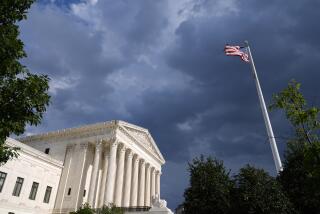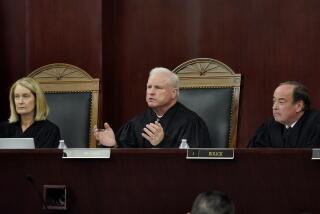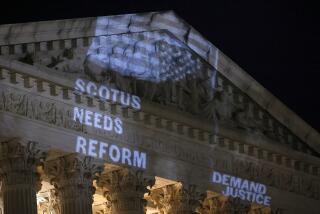Legal, Political Landscapes Could Be Realigned
- Share via
WASHINGTON — It’s apocalypse. Now.
When Justice Sandra Day O’Connor announced her retirement Friday, White House aides, senators of both parties and interest groups mobilizing on the left and right all agreed on one point: The stakes in the struggle over her successor amount to nothing less than control of the Supreme Court.
Because O’Connor so often has been the decisive swing vote on a closely divided court, her successor could determine the balance between left and right on a wide range of controversial economic and social issues.
That virtually guarantees that her departure will provoke a more intense fight, with even greater political consequences for the two parties, than the event most in Washington had anticipated this week: the retirement of Chief Justice William H. Rehnquist. Since Rehnquist is a reliably conservative vote, replacing him with another conservative would not significantly change the court’s alignment.
“More than one analyst has said in recent years that we are basically a country governed by Sandra Day O’Connor,” said social conservative leader Gary Bauer, expressing a view that is echoed by many liberals. “She has been the swing vote on a host of issues. So the choice, the vacancy, is much more significant even than if Rehnquist stepped down.”
President Bush and congressional Democrats now face high-profile choices in a fight that is likely to eclipse all other issues through this fall -- and potentially could define each side for the 2006 congressional elections as much as any other decision they make in the next 16 months.
The departure of the moderate O’Connor offers Bush a chance to shift the court to the right. His choice could energize his conservative base -- and help mobilize the large turnout among core Republicans that has always been central to his political strategy.
But if the president chooses a nominee whom opponents can portray as extreme, he risks further erosion of his support among centrist voters. Such backing has sagged amid dissatisfaction with the war in Iraq and controversies such as the congressional intervention in the case of Terri Schiavo.
“It is a defining moment in his presidency,” presidential historian Robert Dallek said.
The fight could define Democrats too.
Senate Democrats will face intense pressure from their base to oppose virtually any Bush nominee. But if they try to block a choice most Americans see as reasonable, they risk further alienating the culturally conservative and rural voters whom many in the party consider critical to their prospects in 2006 and 2008.
“If Bush comes out with a moderate conservative, then I think Democrats have to be very careful not to oppose just for the sake of opposing, especially if they want to reach some of those centrist and religious voters in the next election,” said James Guth, a religion and politics expert at Furman University in South Carolina.
All of these calculations will play out amid the cacophony of what could become the largest and loudest interest-group campaign in modern times.
In the last two heavily contested Supreme Court nominations -- Robert H. Bork in 1987 and Clarence Thomas in 1991 -- talk radio was in its infancy, the Internet was used largely by scientists, CNN was the only cable news network and issue advertising was rarely employed in lobbying campaigns.
In terms of the political tactics employed, this fight may mark as great an advance as the mechanized blitzkrieg of World War II did over the grinding trench warfare of World War I. Coalitions on the left and right have stockpiled huge sums for advertising and organizing efforts on the court vacancy. In states with senators considered persuadable, the advertising and lobbying could approach the levels seen in presidential campaigns.
“It is going to be huge,” said Eli Pariser, executive director of the political action committee associated with MoveOn.org, the giant online liberal advocacy group.
Further unsettling the environment is the controversy still surrounding the deal on judicial nominations reached in May by the so-called “Gang of 14” senators. In that accord, seven Republicans blocked a bid by GOP leaders to exempt judicial nominations from the filibuster, a tool that allows a minority of 41 senators to prevent a vote on an issue. In return, seven Democrats agreed to allow votes on some of Bush’s nominees and to employ a filibuster only in “extraordinary circumstances.”
If Democrats filibuster Bush’s choice as O’Connor’s successor, the seven Republicans who approved the deal will likely face enormous pressure to recant and support a filibuster ban.
“They will have heat like never before if they fail to do that,” said Jan LaRue, chief counsel for Concerned Women for America, a leading social conservative group.
Sen. John McCain (R-Ariz.), one of the deal’s principal architects, sent a warning shot across the Democrats’ bow Friday. McCain told CNN that Bush deserved deference in his choice after the 2004 election. He also said he did not believe the Bush nominee would “meet the bar of an ‘extraordinary circumstance’ ” meriting a filibuster.
“Elections have consequences,” McCain said. “The burden of proof should lie not with the president, but on the opponents.”
Even as interest groups on both sides brace for a fight, Bush’s choice will largely determine the actual level of hostilities.
The nominations of Bork by President Reagan and Thomas by President George H.W. Bush generated bitter political controversies that convulsed Washington. But David H. Souter, nominated by the elder Bush, and Stephen G. Breyer and Ruth Bader Ginsburg, chosen by President Clinton, sailed to confirmation.
Most analysts think it unlikely that Bush’s choice will experience such a placid ride. Because O’Connor has so often been the court’s tipping point, Democrats and their allied groups have tremendous incentive to resist a nominee even slightly to her right -- someone the White House would probably consider as centrist a choice as it can accept, said David Yalof, an associate professor of political science at the University of Connecticut.
“There is good reason for Senate Democrats to oppose even a moderate-to-conservative nominee, because [he or she] will hold the balance of power,” said Yalof, author of “Pursuit of Justices,” a study of high court nominees.
Adding to the likelihood of confrontation is the pressure Bush will face to nominate someone toward the conservative end of that spectrum.
On most issues, including taxes, energy development and his nominations for the federal appellate courts, Bush has generally pursued policies that excite his conservative base, even at the price of antagonizing Democrats. And conservatives made it clear Friday that they expected Bush to fulfill his campaign-trail promise to appoint a justice similar to Thomas and Antonin Scalia, two of the court’s most conservative members.
“The fact that O’Connor has been known as a swing vote and a moderate should not make any difference” in Bush fulfilling his promise, LaRue said.
Many Democrats urged Bush on Friday to select a consensus nominee. But without predicting Bush’s choice, one GOP strategist familiar with White House thinking said the president was unlikely to disqualify a choice he preferred simply on the grounds that he or she might polarize the country and Congress.
“President Bush really wants to leave an imprint on all sorts of areas,” said the strategist, who asked not to be identified while discussing White House planning. “That’s what is going to drive his decision making process.... He prefers unity to polarization, but he’s not willing to give up his convictions because it may be a polarized debate.”
More to Read
Get the L.A. Times Politics newsletter
Deeply reported insights into legislation, politics and policy from Sacramento, Washington and beyond. In your inbox twice per week.
You may occasionally receive promotional content from the Los Angeles Times.










